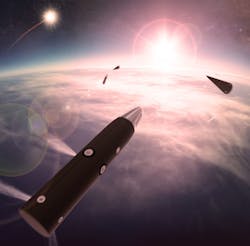Lockheed Martin to build THAAD radar- and infrared-guided ballistic missile defense rocket interceptors
HUNTSVILLE, Ala. – Missile defense experts at Lockheed Martin Corp. will build radar- and infrared-guided missile-defense rocket interceptors for the U.S. and Saudi Arabia to protect against incoming ballistic missiles under terms of a $1.4 billion order announced late last month.
Officials of the U.S. Missile Defense Agency (MDA) in Huntsville, Ala., are asking the Lockheed Martin Missiles and Fire Control segment in Dallas to build Terminal High Altitude Area Defense (THAAD) interceptors and associated one-shot devices.
THAAD is designed to shoot down short-, medium-, and intermediate-range ballistic missiles in their terminal phase using a hit-to-kill kinetic warhead. The THAAD interceptor missile relies on the kinetic energy of the impact to destroy the incoming missile.
THAAD uses the AN/TPY-2 ground-based X-band radar from Raytheon Technologies Corp. for guidance and navigation, and the interceptor has an indium-antimonide imaging infrared sensor seeker from the BAE Systems Electronic Systems segment in Nashua, N.H.
Related: Electro-optical sensors key to missile defense
The Raytheon AN/TPY-2 radar is one of the largest air-transportable X-band radar systems in the world. It searches, tracks, and discriminates objects and provides updated tracking data to the interceptor.
The BAE Systems infrared seeker head, meanwhile, is an integral part of the THAAD guidance system. It uses advanced electro-optical sensors to seek and lock onto incoming enemy ballistic missiles that are moving as fast as 17,000 miles per hour. The radar and infrared seeker work together to route the THAAD interceptor to the threat.
BAE Systems is the original manufacturer of the THAAD interceptor infrared seeker head. The company won a contract from Lockheed Martin in 2020 to design and manufacture next-generation THAAD infrared seekers to improve the interceptor’s ability to neutralize threats and improve its manufacturability.
BAE Systems officials also plan to work on the advanced infrared seeker at a new facility in Huntsville, Ala. Other key THAAD subcontractors are Boeing, Aerojet, Rocketdyne, Honeywell, and Milton CAT. Deployment of the THAAD system began in 2008.
Related: Lockheed Martin to build IR space surveillance sensors
THAAD is a key element of the U.S. ballistic missile-defense system to defend the continental United States, its deployed forces, and allies against ballistic missiles of all ranges and in all phases of flight.
THAAD consists of five major components: launchers, interceptors, a radar, THAAD fire control and communications (TFCC) units, and THAAD-specific support equipment.
Lockheed Martin started developing the THAAD system in 1992, and first tested the system three years later. The first THAAD tests that hit their targets were in 1999, after the first six ballistic missile-defense tests missed. THAAD missiles, which have a maximum range of about 125 miles, are expected to hit incoming ballistic missile warheads as high as 93 miles above the Earth's surface.
On this order Lockheed Martin will do the work in Dallas; Sunnyvale, Calif.; Huntsville and Troy, Ala.; and Camden, Ark., and should be finished by August 2027. For more information contact Lockheed Martin Missiles and Fire Control online at https://www.lockheedmartin.com/en-us/who-we-are/business-areas/missiles-and-fire-control.html, or the Missile Defense Agency at www.mda.mil.
About the Author
John Keller
Editor-in-Chief
John Keller is the Editor-in-Chief, Military & Aerospace Electronics Magazine--provides extensive coverage and analysis of enabling electronics and optoelectronic technologies in military, space and commercial aviation applications. John has been a member of the Military & Aerospace Electronics staff since 1989 and chief editor since 1995.
